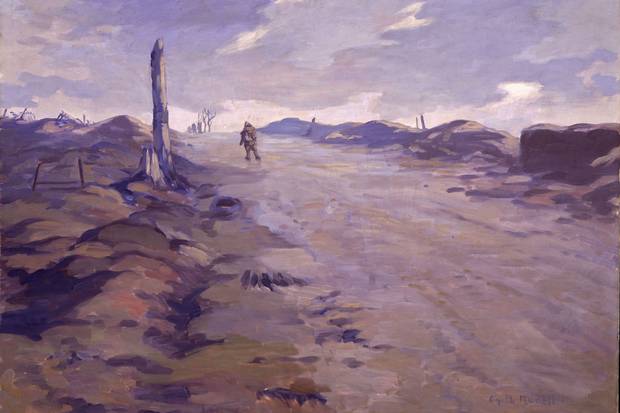It took just four days of armed struggle to launch a century of commemoration, myth-making and downright fantasy about the Battle of Vimy Ridge. Whatever else it may be, or has been claimed to be, Vimy is Canada's favourite battle with which to unite or divide the nation.
With the battle's centenary coming up on April 9, we're again being told to repeat that Canada was born in 1917, on a muddy hill in northern France. Other voices urge us to resist slipping once more into a chivalric wonderland, where force of arms can confirm the nationhood of millions who have never seen a battlefield.
Historians are still duelling over whether Vimy was more important to the war effort than other Canadian engagements – Arthur Currie, the senior Canadian commander at Vimy, thought it wasn't. Fewer analyze the idea that something so complex as a nation can be born on a distant ridge because young men are fighting there. How can this archaic notion have dug in so deep, and lasted so long?
Two recent books take up the quarrel from opposing sides, adding to a long shelf of Vimy literature. Military historian Tim Cook's cautiously celebratory Vimy: the Battle and the Legend is the revised standard gospel, insisting on the resilience of the legend while acknowledging that the subject is "a layered skein of stories, myths, wishful thinking and conflicting narratives." Ian McKay and Jamie Swift's The Vimy Trap, a finalist for this year's Shaughnessy Cohen Prize for Political Writing, is an impatient piece of debunkery that sees Vimy as a propaganda tool used to justify more recent conflicts, including the war in Afghanistan.
Vimy as an event that cost 3,598 Canadian lives and wounded 7,000 is fixed in time, but its af-terimage is ever-changing. A graph of its presumed importance would show several valleys between peaks of interest in 1936, when the Vimy Memorial in France was completed; in 1967, the battle's 50th-anniversary year; and in the 11 years since Stephen Harper became Canada's highest-ranking enthusiast of our military history.
The past decade or so has been in many ways the climax of the parade, the period of the battle's widest renown and most unanimous official support. It has also been a time of maximal doubt and equivocation about the battle's importance in history, its meaning in different eyes, and its right to be hailed as a landmark of Canadian experience. As Mr. Harper might have said, we flock to celebrate the battle – 25,000 are expected this year at the Vimy Memorial in France – but we also commit sociology about it.

Naval guns fire during the battle at Vimy Ridge in April, 1917.
NATIONAL ARCHIVES OF CANADA
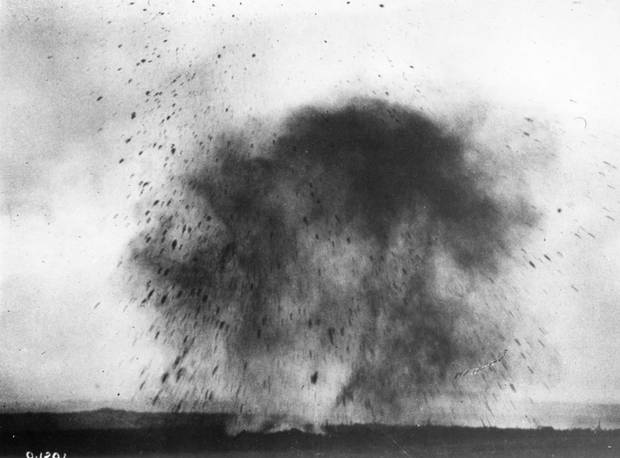
A German shell explodes during the taking of Vimy Ridge.
DEPARTMENT OF NATIONAL DEFENCE/LIBRARY AND ARCHIVES CANADA
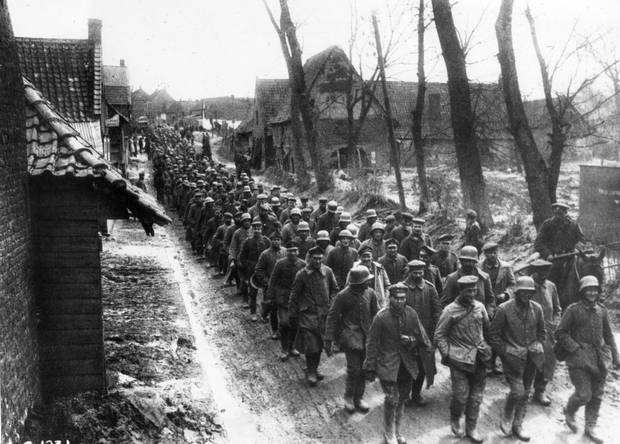
German soldiers captured at Vimy march toward a prisoner-of-war camp.
DEPARTMENT OF NATIONAL DEFENCE/LIBRARY AND ARCHIVES CANADA

Canadian graves on Vimy Ridge. The battle killed 3,598 Canadians and wounded 7,000.
DEPARTMENT OF NATIONAL DEFENCE/LIBRARY AND ARCHIVES CANADA
The taking of the ridge was the brief and deadly coda to a months-long campaign of stealthy preparation, led by British Lieutenant-General Julian Byng. The website of the Vimy Foundation, set up in 2006 to keep the battle's fame bright, claims to see, in the methodical planning, the blueprint for a peculiarly Canadian brand of warfare, unlike the "flamboyant valour or dogged sacrifice" favoured by other nations.
But the command, much of the artillery and logistical work (including 12 kilometres of tunnels) and the supporting troops were British, as were a large number of the soldiers in Canadian uniform. According to Cook, 60 per cent of the first Canadian Corps recruits were British-born. In the Saskatchewan battalion of Lieutenant Colonel D. E. MacIntyre, according to his 1967 account of the battle, Brits accounted for 80 per cent of the men in arms.
Quite a few had probably been in Canada only a few years. Immigration was booming in the years leading up to the war, and half of the newcomers were British. In 1913, a record 400,810 immigrants entered the country, boosting the population by 5.5 per cent. They arrived just in time for the collapse of a land-speculation boom, a terrible wheat crop and a surge in unemployment. A soldier's pay and a chance to help the Empire win a war that most expected to be short must have seemed, to many of them, a lucky break.
In the context of the five-week Arras offensive of which it was a part, the battle at Vimy Ridge was a blip of success in a disappointing campaign that ended Allied hopes that the war could be won by summer.
"Canadians Lead in Triumph," said The Globe's front page, which assigned the victory to overall British commander Douglas Haig. The Globe didn't mention the birth of a nation: It had already seen that at the Second Battle of Ypres in 1915, where "Canada was christened into nationhood." Max Aitken (later Lord Beaverbrook) recycled that characterization of Ypres in his 1916 bestseller, Canada in Flanders.
As Dr. Cook says, the birth or baptism metaphor was not a major part of early Vimy commemoration. A more important element was the Christian theme of death and resurrection, which arose initially because the battle happened to begin on Easter Monday.
The theme was given visible shape in Walter Allward's monument at Vimy (1921-1936), and in the bronze CPR memorials in Vancouver, Winnipeg and Montreal, which show an angel bearing a dead soldier up to heaven, while holding a victor's laurel wreath above his head.
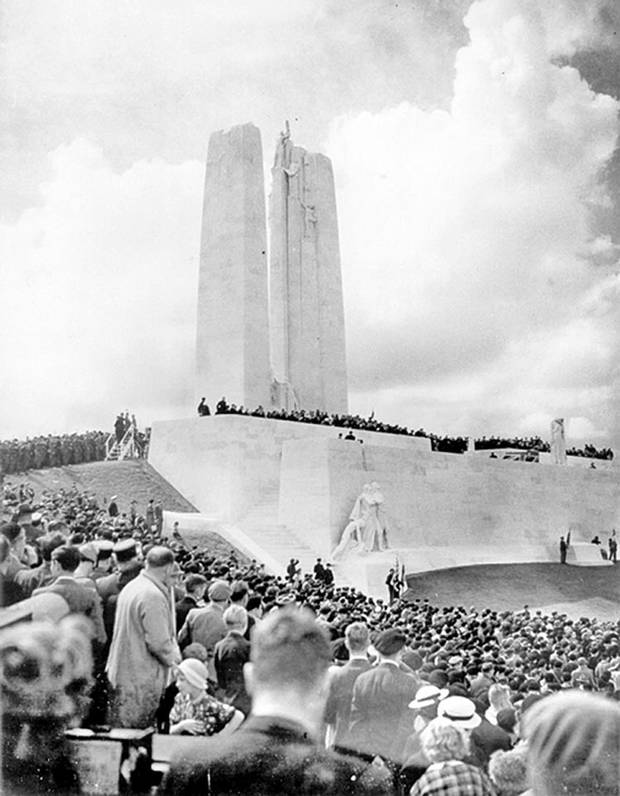
Thousands gather at the newly unveiled Vimy Ridge Memorial on July 26, 1936.
LIBRARY AND ARCHIVES CANADA
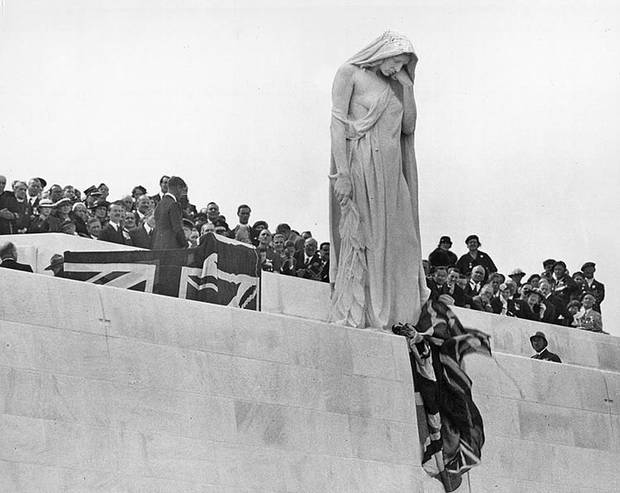
King Edward VIII presides over the ceremony at the memorial built on 290 acres of land granted by the French government to Canada as a permanent memorial park.
LIBRARY AND ARCHIVES CANADA
It wasn't until 50 years after the battle that the birth of a nation became a key part of the narrative. A spate of memoirs by Vimy vets in 1967 all endorsed the idea, through a long retrospective lens coloured by the nationalism of that centennial year. Prime Minister Lester Pearson used the birth-of-a-nation metaphor at the Vimy Memorial that year, even though his winning of the Nobel Peace Prize in 1957 had made him a symbol of a new image for Canada, as a peacekeeping nation.
As memoirs and historical accounts proliferated, so did fabrications that boosted the importance of the engagement, or Canada's role in it. Historica Canada, a private foundation and producer of a misleading Heritage Minute about Vimy, still claims on its website that the taking of the ridge "was considered the turning point of World War I." It was nothing of the kind. Historica's Vimy page also erroneously assigns overall command to Arthur Currie, the senior Canadian officer under Lt.-Gen. Byng, who isn't mentioned.
The unity felt at the front by soldiers was real, driven by army discipline and a shared experience of mortal danger. But this is a feature of all modern warfare, in which the "spectacle and valour" of traditional warrior culture, as sociologist Anthony Giddens describes it in his book, The Nation-State and Violence (1985), are subsumed into a uniformed body of men acting as a team.
Canadians often imagine that the lack of a war of independence left a hole where some of our national spirit should be. But as Mr. Giddens writes, wars of liberation in the Americas often had sketchy long-term goals that did not always turn out to be unifying. In the future U.S., he writes, "the feasibility of linking the heterogeneous and, at that time, isolated British colonies into a single state was early on doubted even by some of the main proponents of the American Revolution."
For a battle in France to become part of a Canadian creation story, the idea had to spread, as historian Jonathan Vance says, "that it was not battalions and brigades that fought their way up Vimy Ridge, but the nation itself." The ridge had to become an imaginative space, in which the whole of Canada could gain a new and continually renewable sense of nationhood through the action of a few. It was this imaginative space that Stephen Harper claimed at the Vimy celebrations in 2007, more fully perhaps than any previous prime minister. "There may be no place on Earth that makes us feel more Canadian," he said, though the nearest point of Canadian soil was 4,000 kilometres away.
But if the Vimy battalions were leading the nation up the ridge, who or what was being overcome? Not the Germans, who never impeded Canadian nationhood, but the British Empire, for whose sake and at whose command Canada entered the war. Our ally was also the power we had to transcend. As Vimy vet F. F. Worthington wrote in another 1967 history of the battle, after Vimy, "to be British was not enough; we were Canadian and could do a good job of paddling our own canoe."
The problem with this scenario is that years before the First World War began, Canada had already established a position in international affairs that was distinct from Britain's.
In 1899, England went to war against Boer independent republics in what is now South Africa, and asked Canada for help. Prime Minister Wilfrid Laurier refused to fall in with this nakedly imperialistic adventure, agreeing only under pressure to allow 1,000 volunteers to serve in Canadian uniform.
Later recruitments were financed by the British, who praised the Canadians for their "bravery, dash and courage" – words repeated after Vimy in 1917. Mr. Laurier made it clear that the Boer War set no precedent for Canadian involvement in future British campaigns.
At Colonial Conferences in 1897 and 1911, Mr. Laurier heard proposals that the colonies join a joint Imperial council, and that they pay into a common Parliament of Defence. He rejected both as an affront to Canada's independence, sarcastically summarizing the proposals by saying: "We must have a body above us to force us to be good boys and pay our share." As he saw it, we Canadians were well capable of paddling our own canoe.
But since Britain and other European powers had begun a rush for new territories in Africa and Asia in the 1880s, a new wave of imperial feeling was stirring in Canada. David Ross McCord, founder of the McCord Museum in Montreal, was fond of leading guests through imaginative recreations of the Battle of the Plains of Abraham on his front lawn, saying: "Can't you hear the conquering volley of that gallant British Army ringing down through the centuries?" Stephen Leacock, while a professor at McGill University, wrote in his bestselling Elements of Political Science (1906, revised in 1913) that independence for the Dominion of Canada "has now receded into the background," and that with the expansion of Britain's Empire, "the smaller destiny of isolated independence is set aside in favour of participating in the plenitude of power possible in union." He cited the Boer War as having enhanced a yearning for "imperial federalism."
By 1914, Mr. Laurier was out of power and Robert Borden, the Conservative prime minister, seemed to have forgotten the independent stance taken by his predecessor. As soon as Britain called Canada to the war, Mr. Borden committed 500,000 troops and 1.5 million sacks of flour, without consulting his cabinet. His war policy at home included dunning farm families simultaneously for more grain and more recruits, limiting civil liberties, and revoking the voting rights of immigrants from "enemy" nations. He loaded the country with $3-billion in war debt, sowed lasting suspicion between East and West and allowed the country to devolve into a mean-minded community where shirkers and profiteers were thought to be everywhere. The feeling of unity that D. E. MacIntyre experienced at Vimy, he recalled in 1967, "was not dominant at home."

A Canadian battalion marches past Sir Robert Borden, then prime minister of Canada, in France on July 1, 1918. General Arthur Currie, the senior Canadian commander at Vimy Ridge, is on the right.
NATIONAL ARCHIVES OF CANADA
Mr. Borden's war legacy includes a positive contribution to Canadian sovereignty, through his push for a resolution at the Imperial War Cabinet in April, 1917, which formally recognized the Dominions as "autonomous nations of an Imperial Commonwealth." After Resolution IX, says Dr. Cook, Canada would control its own foreign policy. This unglamourous achievement had a real effect on the Canadian nation, not as a spiritual entity but as a collective, living together in defined territory with key values and a unified administration.
But later that spring, Mr. Borden imposed conscription, and when Quebeckers demonstrated against it, had them shot down with rifles and machine guns. Four were killed and dozens wounded when soldiers opened fire on a crowd in Quebec City on Easter Sunday, 1918 – almost exactly a year after the Vimy victory that is supposed to have brought Canada together as never before. As Dr. Cook points out, "the memory of the Quebec riots would live on, acting as a powerful counternarrative to the story of Vimy as a nation-building event."
So would Beaumont-Hamel, where most of the Newfoundland Regiment was cut down in 30 minutes on the first day of the Battle of the Somme in 1916. Newfoundland was a Dominion, like Canada, but it experienced no nationalist epiphany through combat. It found mainly grief, at a waste of life for no measurable result. The cost of raising the regiment, which renewed itself and fought with distinction throughout the war, beggared the island's government, and is seen by many as key to its loss of independence in 1934 and half-hearted entrance into Canada in 1949.
In 1986, Pierre Berton's best-selling book Vimy vaulted the battle back into popular consciousness, with a ripping tale of rustic Canadians measuring up shot for shot with their class-bound British counterparts. Mr. Berton was pro-Vimy, at a symbolic level, but even he asked: "Was Vimy simply used as a convenient symbol, a piece of shorthand to stand for a more complicated historical process that, in the end, was probably inevitable?" He decides, in effect, that it doesn't really matter. The symbol was up and showing all signs of life.
Historian Benedict Anderson says that part of being a nation is getting your own history wrong. We began telling ourselves tales about Vimy in part because we needed to make sense of Canada's war sacrifice in a postimperial nation. Mr. Borden's explanation, that we had "to ensure the integrity and maintain the honour of our Empire," doesn't cut it any more. We can't be satisfied by the idea that this war was not fought to defend anything or anyone in the imagined community of Canada.
For at least a generation, we've also been as likely to encounter the First World War through video games as through books, films or commemorative events. Multi-player games such as Verdun offer exciting simplified narratives and immediate personal connection. In a weird secular echo of early conflations of Vimy with the Easter tale of death and resurrection, video war games also feature a full return to fighting condition after each death. Gaming and sports fans knew exactly where hockey commentator Don Cherry was coming from when, in 2012, he called the Vimy troops "the first Team Canada."
The actual battle at Vimy was won with the blood and death agonies of troops who never left the site and are buried there. For the rest of us, Vimy is both a sombre mental artifact and a role-playing national game, in which we are invited to see ourselves in a conflict that has no remaining survivors. Some of us will never take up that invitation; it's too much about someone else's Canada. Contrary to much that has been said or implied during this 150th anniversary year, we have never had a unified national narrative. There is no single "story of us," as a new historical TV series would have it, at Vimy or anywhere else.
Robert Everett Green is a feature writer at The Globe and Mail.
CANADA AT WAR: MORE FROM THE GLOBE AND MAIL
After Vimy, there was the Battle for Hill 70. Here’s what you need to know about the forgotten conflict
